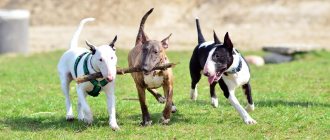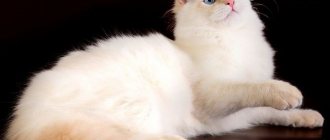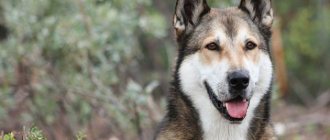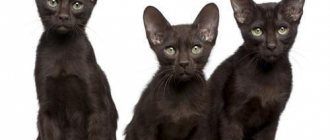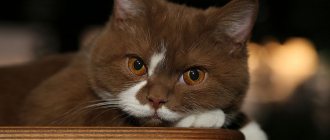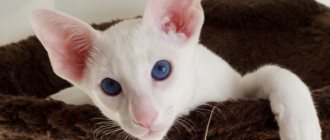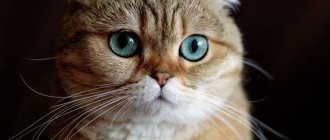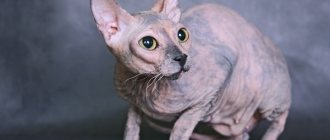- Pets
- >>
- Cat breeds
* Here is a photo of a typical representative of the Norwegian Forest Cat breed . You can send us photos of your animals by email, and we will post them on the website. Don't forget to send your pet's name.
Other breed names:
Norway
Video
* We invite you to watch a video about the Norwegian Forest Cat . In fact, in front of you is a playlist in which you can select and watch any of 20 videos about a given cat breed by simply clicking on the button in the upper right corner of the window. In addition, the material contains quite a lot of photos. By looking at them you can find out what a Norwegian Forest Cat looks like.
In this article:
|
Rate the material!
[Total votes: 0 Average: 0]
Despite its name, the Norwegian Forest Cat is a domestic pet. This is a native breed of Norway and its name in local dialects is derived from the word "forest". In its classic version, it really resembles a wild animal, shaggy and striped. The breed is equally well suited for city apartments and rural houses.
Photo review
For those who are thinking about buying a Norwegian Forest cat kitten, but still have doubts, it is useful to look at a selection of photographs. Kittens and adult cats differ from most cats in their royal pubescence, strong physique, and natural colors and shapes. Photos of Norwegian Forest cats only partially convey the natural grace of the breed.
History of the origin of Norwegian forest cats
One version of the origin of the breed states that it was given rise to long-haired cats, which were brought to Norway by the Crusaders in the Middle Ages. They were called "Angora", although they are not identical to the modern breed with that name. Having survived in the harsh conditions of the countryside, where cats had to hunt a lot, escape from enemies and endure frosts, the descendants of the ancient Angoras retained their lush fur and acquired a camouflage “wild” coloration.
According to another version, the ancestors of the Norwegian Forest were Viking ship rat catchers. But perhaps its roots are deeper and connected with the wild forest cat, common in Europe. In Norway, such cats lived 5,000 years ago, as evidenced by the discovered remains.
Whoever helped create the breed could only get genes from these three sources. Therefore, the standard does not allow Siamese, chocolate and cinnamon colors, the carriers of which could not enter Norway at the time of the formation of the Norwegian Forest.
Norwegian forest cats became known to felinologists after an exhibition in Oslo in 1938. The red-and-white cat received the status of “National Cat of Norway”. After the war, in 1963, the country's felinologists united into the National Association of Pedigree Cats (NRR). They continued breeding the breed and in 1972 developed a program to preserve it. In 1976, only 100 animals were registered.
Interesting fact: In 1977, the FIFe recognized the Norwegian Forest as an independent breed. Now it is recognized by almost all felinological organizations.
Currently, the Norwegian forest breed is especially popular in its homeland, Sweden, Iceland and France. In our country, it competes with the domestic Siberian cat and the American Maine Coon. Although there are many nurseries specializing in breeding Norwegian Forest (NFO).
History of the origin of the breed
There are many versions of the origin of the Norwegian Forest breed . One of the most reliable versions is that Angora cats were brought to Norway by the Vikings. Finding themselves in the harsh climatic conditions of Scandinavia, such animals naturally crossed with aboriginal shorthaired cats.
This is interesting! The process of adaptation to cold and bad weather was accompanied by the appearance of a very thick undercoat, strength and flexibility, agility and endurance. Among other things, unfavorable external factors also affected the size of Norwegian cats.
Another version has become equally widespread, according to which the Norwegian Forest was the result of crossing a lynx and a domestic cat. This original origin story is partly “confirmed” by the animal’s adaptability to climb tall trees very dexterously and easily, as well as by the presence of characteristic “tassels” on the ears and powerful, well-developed predatory claws.
At the beginning of the twentieth century, the result of active crossing with many other breeds was the almost complete degeneration of the Norwegian forest cat. This deplorable situation could only be corrected by introducing a ban on interbreeding.
In the last century, the Norwegian Forest breed was registered as an official breed, and recognized by FIFE as an experimental breed. From that moment on, the process of breeding purebred Norwegian cats began in their historical homeland and in many other countries. Currently, the breed is recognized by almost all felinological organizations in the world.
Return to content
Norwegian Forest Cat - description of the breed
According to the CFA standard, the Norwegian Forest Dog is a strongly built animal with a magnificent two-layer coat and a characteristic lynx figure. Individuals of the breed develop slowly, reaching full bloom at the age of about five years. A cat weighs 6-9 kg, a smaller cat weighs 4-6 kg.
Description of Norwegian Forest Cats:
- The head is triangular, the distances from the outer part of the base of the ear to the end of the chin and between the ears are of the same length. The forehead is flat, smoothly rounding towards the crown. The chin is strong, but does not protrude beyond the tip of the nose;
- The neck is short and muscular;
- The ears are medium or large, rounded at the tips, widely spaced, alert. Tassels at the ends are desirable, but not required;
- The eyes are large, almond-shaped, well-opened and expressive, slightly slanted;
- The body is muscular and harmonious, massive but not fat, with a broad chest and strong bones. An impressive appearance is especially important for cats; female cats can look more graceful;
- The legs are muscular, the hind legs are somewhat longer, with powerful thighs;
- The paws are round, large, with lush tufts of hair between the toes;
- The tail is very long and thick. It is valued if its length is equal to the entire body to the base of the neck;
- Coat with a well-defined dense undercoat and long, smooth and hard guard hairs on the sides and back. The collar, sideburns, bib, and trousers on the hind legs are well defined.
Grounds for disqualification:
- Small size, weak bones;
- The head is round or square;
- Profile with a break, the presence of a stop;
- Small eyes, too spaced, narrow;
- Legs short or thin, short tail;
- Clear signs of hybridization, manifested in the color of the Himalayan type or chocolate, cinnamon, lilac.
Description of the breed
Thanks to its size, fluffiness and truly aristocratic appearance, the Norwegian forest breed always attracts attention. Standing out among others, the Norwegian is characterized by the following features in appearance.
Head
From the front it looks like a triangle, with a flat forehead. The profile is straight. The nose is medium in size, pink in color without a pronounced stop. The jaws are impressive. The chin is rounded.
Eyes
Large, obliquely set eyes have an elongated shape. The color of the iris is predominantly shades of green and gold. White cats have heterochromia.
Ears
Medium or large, with a wide base. The tips are rounded, tassels are possible. The inside of the ears is covered with fur.
Body
Elongated, medium to large in size with well developed muscles. The bones are strong.
Paws
Powerful and wide. The front legs are significantly shorter than the muscular hind legs. There are tufts of wool between the fingers.
Tail
Cats of this breed are famous for their beautiful fluffy tail. Flexible and strong, it is proportional to the body of the animal.
Six
Medium length with a thick, soft, slightly wavy undercoat. The hair is smooth and has water-repellent properties. Cats are characterized by a “collar”: long hair around the neck, flowing down to the chest, reminiscent of a lion’s mane.
Norwegian forest cat photo
Colors
The large range of colors is due to the habitat of the Scandinavian ancestors. The color of the coat was camouflage and a guarantee of a successful hunt for the predator. The following types are distinguished:
- Monochrome – black, grey, white, blue.
- Smoky - stretching from the white base of the hair to a dark gray color.
- Ticked - the hair is colored in stripes, there is no clear pattern.
- Warm shades from red to red.
- Tabby - color with spots, stripes (brindle).
- Marble – tortoiseshell (tri-color) color.
- Combination with white - plain with white legs, belly, etc.
At exhibitions, high demands are placed on the color of a pet. For example, a cat in a solid color should not have any admixtures of any additional color, while tabby and tortoiseshell must have a clear pattern.
video
Dimensions and weight
The standard does not specify precise measurements of these parameters. The Norwegian cat breed looks very powerful: due to its thick, long hair, it appears larger. Experienced breeders noted that the normal height is 30-40 cm. Weight is determined by the sex of the animal: the average weight of a cat is 5.5 kg; cats are larger and can weigh about 9 kg.
Popular colors of Norwegian forest cats
Numerous colors are described in particular detail in the CFA standard. The colors of the eyelids, paw pads and eyes, which should correspond to each color, are also indicated there. As for the general requirements, green, gold, copper eye colors are acceptable. Cats with white may have blue or different eyes. Skin areas of any color are allowed. Buttons and/or medallions are acceptable in any color. The color of the pubescence around the muzzle and ear tufts is assessed separately.
Abbreviated list of CFA colors:
- Plain. White, black, blue, red, cream. Nose and paw pads match the color of the fur coat or pink if the color is light;
- Chinchilla. Silver - white undercoat, black-tipped guards, white from chin to belly, black eyelids and paws. Golden - the undercoat and underbody are cream, the rest is the same. There are also red (cameo), tortoiseshell, and shaded versions of all of the above colors;
- Smoke. Color black, white undercoat. Nose, eyelids, paws black. Similar smokes of blue, cream, blue-cream, red, tortoiseshell colors;
- Tabby colors. Various spotted and striped patterns. The classic tabby has rings on its legs and neck and an “M” pattern on its forehead. The outer corner of the eye is continued with a line, there are patterns on the cheeks, and butterfly-shaped markings on the shoulders. Lines are drawn along the body, spots in concentric circles on the sides, and the pattern is symmetrical on both sides. Any colors, including in different combinations;
- Calico. White with red and black spots. White legs, belly, chest, muzzle;
- Two-color. Combine spots of any color with white;
- Amber colors. The predominant color is dark honey-chestnut. Kittens are brown. The nose and paws are dark brown or black. There are amber smoke, chinchilla, tabby, and turtle.
Character and habits of Norwegian forest cats
Despite their stern appearance, Norwegians have a gentle disposition and are relatively docile. They are easy to train and can be safely kept in a city apartment. They are balanced, have strong nerves, and can tolerate communication with capricious children and other pets.
They become strongly attached to people from their family and love their company, without which they miss. It cannot be said that they particularly single out the owner - they are friends equally with everyone. They can accompany you on short walks. But they behave reservedly with strangers and do not immediately make contact, gradually getting used to it.
They are active in nature and love to play. They are able to entertain themselves if they are given toys and do not require them to be occupied with them. Able to adapt to any situation after a short period of stress. Having transported them to a new place, you need to leave them in the house for a while so that they get used to the place and calm down among familiar people.
Interesting fact: Norwegians are excellent hunters. They will especially like life in the countryside. Catching rodents is their traditional occupation. But they are no less capable fishermen. They confidently climb trees, and Norse myths emphasize their ability to climb steep cliffs, which is inaccessible to ordinary cats.
Norwegian Forest cats have a quiet voice, but can become loud if kept in a home with a dog. As they say: “Whoever you mess with...”. You should not try to force the cat to sit on your lap - it will begin to express dissatisfaction. This especially applies to females, who are more proud and independent. Cats, as a rule, are more affectionate and more interested in family affairs, taking part in them. On the other hand, one can more likely expect hooligan antics from them.
Forest cats, varieties (19 photos)
Author: Yugansk
27 January 2021 20:22
Tags: Forest cats Photographs. animals interesting nature
4847
19
We are all somehow accustomed to an ordinary cat, living next to a person for centuries. Everyone knows the familiar pet purring near a saucer of milk. But not their wild counterparts living in the forests of Eurasia and the African continent. There are several representatives of the wild cat species.
1.
0
See all photos in the gallery
Forest cats are usually slightly larger than domestic cats and are well adapted to life in the wild. Having met a handsome wild animal in the forest, you should not think that it is Vaska who has gotten lost, but let the animal go its own way.
2.
0
Decent size is the main difference between the European forest cat and once domesticated species. The length of the body can reach 80 centimeters, the weight of individual individuals, depending on the species, starts from 3 kilograms and ends at 11. The tails are also different: their length is up to 30 centimeters, “chopped off” by nature, it is quite thick and very fluffy. The longest hairs grow at the tip of the blunt tail. The paws are also larger, and the sharp claws are retracted into the “sheath” when walking. In winter, wild cats sport a thick dark coat, but by summer they change it to a lighter coat. Forest cats are usually heavily decorated with dark stripes. Their large ears are devoid of tassels, and their eyes mysteriously glow with yellow-green lights. Widely spaced ears provide the animal with excellent hearing, and the eyes are able to discern a small rodent rustling in the forest floor. Forest predators have stereoscopic vision; scientists say that these cats distinguish colors.
3.
0
Whiskers, called vibrissae, are not only an ornament to a cat's face, but also a sharp sensory organ. Subtle natural sensors will tell the cat about prey approaching at a distance favorable for hunting, and will help in “calculations” about the possibility of movement in narrow places. The inhabitants of the African continent are inferior to their Eurasian counterparts in size and weight, but their skins are painted in lighter shades.
4.
0
Norwegian Forest Cat The Norwegian Forest Cat is a fluffy beauty from Scandinavian myths. Legends describe a predator with the name “Forest Cat”, capable of running along steep cliffs. Similar Norwegian cats carried the beautiful goddess Freya in harness. In our time, the king took the beautiful animal under his personal protection, granting him the status of a national cat. For centuries, the Norwegian forest cat lived next to people, some individuals served as mousecatchers on merchant ships. This type of forest cat was even exhibited at the International Cat Show in Germany in the last century. Recognition of the Norwegian Forest Cat as a separate breed saved the subspecies from extinction. Cats were brought to Russia, and through human efforts they reached the United States. Professional breeders started breeding the breed. It has been proven that this is a Norwegian cat - the closest relative of the May Coon.
5.
0
The Norwegian forest cat is the largest subspecies, reaching a mass of ten kilograms. Strong paws allow them to run head down from almost vertical surfaces. But as your pet ages, joint problems appear. The Norwegian forest cat living in the north is better insulated than other subspecies. There is thick fluffy fur and abundant undercoat. The ears and spaces between the fingers are covered with a warming layer.
6.
0
Caucasian forest cat The Caucasian forest cat is a subspecies protected by the Red Book; it was hunted too much in the last century. Lives in the highlands of the Caucasus and Turkey. They live alone, hunt small rodents and birds, but can feast on a hare or a weakened roe deer. Typically, the Caucasian forest cat is gray in color with pronounced dark stripes, but there are also black specimens. This subspecies of the forest cat has changed the least; it does not interbreed with domestic cats. The subspecies is distinguished by its large size; the male Caucasian forest cat often reaches ten kilograms. By winter it acquires insulated fur, which allows it to hunt in mountain winter conditions.
7.
0
In Dagestan, cats have taken a liking to the river banks; the inhabitants of Georgia often go down to the sea beaches. And in the area of Batumi and Poti, the Caucasian forest cat lives in the “wet” conditions, hunting every day in rivers and walking on wet dirty grass. The local forest cats even swim in streams when hunting for fish.
8.
0
Far Eastern forest cat The Far Eastern forest cat “disguises” itself as a small tawny leopard. His light coat is evenly covered with red “leopard” spots.” This is a skilled nocturnal predator that lives in hard-to-reach places. The Far Eastern forest cat is a close relative of the Amur forest cat; sometimes they, descendants of the Bengal cat, are combined into one subspecies. The Amur forest cat is distinguished by three dark stripes stretching along its back and light sides. The body is strewn with coin spots, for which the Chinese nicknamed this subspecies “money cat.”
9.
0
Amur forest cat The Amur forest cat has inhabited the forest expanses of the Far East, its habitat extends to the Amur, the coast of the Sea of Japan, reaches Hindustan, the Malay Archipelago. Many forest cats of this subspecies live in the lands of China. Leads a nomadic lifestyle, swims remarkably well, and sometimes lives in pairs. In cold weather, predators move to lowlands not blown by the wind to escape drifts near human habitation. This forest cat gets used to humans better than others; it can be kept in an enclosure, away from strangers. The European wild cat is the most similar to the domestic cat. The same gray skin and stripes, only the fur is tall and thick. Lives in the Caucasus regions, in low mountains, in the forests of Ukraine, in European countries. Selects an area with dense forest.
10.
0
Habitats The forest cat has more than twenty subspecies living in European countries, on the territory of the Russian Federation, and is found in the Middle and Far East. The cat population lives in the forests of Ukraine, Moldova, Lithuania, the Caucasus, Norway, and some species have chosen the expanses of Scotland.
11.
0
The main habitat is beech and hornbeam forests; it can live in floodplains. Prefers lands with a temperate climate, although winter wool provides good warmth in the frosty months. Sometimes it settles on the banks of rivers and seas. Sometimes cats make a safe lair on miniature islands. But the wild cat does not like regions characterized by heavy snow drifts. You won’t find it in places with extremely low winter temperatures. If there are prolonged snowfalls that cover the forest, then free animals migrate closer to human habitation.
12.
0
However, the twentieth century significantly reduced the species number and population size of European forest cats. These animals have taken a place in the Red Books of Belarus, Moldova, and the Russian Federation. The reason was the reduction of forests, cold weather, and traps set by hunters. Sixty years ago in the North Caucasus, industrial production of animals was carried out, shot for their fur. The subspecies that lived in Dagestan have almost disappeared, due to cold winters and a reduction in the number of rodents. Now the population of the local species is being restored in the Teberdinsky and Caucasian nature reserves. Representatives of the species that lived en masse in Polesie (Ukraine) have almost disappeared, but a decent number of cats live in the highlands of the Carpathians and in the Danube floodplain.
13.
0
Lifestyle and habits The forest cat is a sybarite of the wild, preferring to hunt in the most comfortable conditions. It goes out for food in the evening or pre-dawn twilight, when the sun is about to set or rise, and the forest falls asleep or peacefully dozes before the morning awakening. The cat will not leave his shelter if it is too cold outside, it is raining or it is simply slushy and unpleasant. He will wait out the bad weather in comfort, and will go for prey when the weather clears up in the forest. The cat is the sole owner of his hunting grounds; he carefully marks the entire territory (a couple of hectares of floodplains or 60 hectares of forest), informing his brothers about the occupancy of the area. It makes regular rounds of the land, walking up to ten kilometers a day, but moves far from the borders only during the mating season. Housing for a forest cat can be a hollow, a crevice in the rocks, or a hole left by the previous occupant. The predator often changes its roosting location, choosing the most abundant food supply. In summer, animals are driven away from their favorite corner by fleas; in winter, they often change their location due to problems with hunting in conditions of high snow cover.
14.
0
Hunts with sharp jumps, instantly grabbing the prey. Excellent vision and hearing, plus signals picked up by the vibrissae, help them hunt in poor lighting, but wild cats have difficulty discerning odors. It can wait for prey near the lair or in “fishy” places. They never stock up, preferring to dine on freshly caught prey. Cats living near ponds hunt from branches overhanging the water and hide in the reeds. From such an ambush, a predator can even overtake a waterfowl. Fortunately, he knows how to swim, although he really doesn’t like getting his fluffy fur wet. He overtakes rodents running freely in trees by quickly climbing the trunk and running across the branches. In the excitement of the chase, in a dense forest, it can even jump from tree to tree. It grabs small animals with its paws, holds it tightly and bites the back of the skull with sharp teeth. The prey, which is superior in mass, tries to “mount” it and inflict a fatal wound in the neck area. The character of a wild cat is radically different from the usual cute cats. These are proud, aggressive loners, accustomed to surviving in the wild. They do not allow people to approach and do not invade the boundaries of settlements unless absolutely necessary. By nature, these cats are silent. But an aggressive attack will be accompanied by a dissatisfied hiss and howl, and courtship play will be accompanied by an inviting meow.
15.
0
Sometimes they try to place a forest cat at home, making it a cute pet. You can try to house a predator like an exotic toy in the enclosure of a country mansion, but it will simply destroy the apartment. Plus, we must take into account that this is a nocturnal resident, marking its territory. In captivity, it will live a long time (up to 30 years), especially if the usual diet is provided. But he won’t become a fluffy, loving ball. Individuals taken as kittens partially lose their natural talents as hunters. But people are still distrustful. He will get used to the family (having first tried to take the main place in the house), but he absolutely cannot stand strangers. He will also not tolerate other representatives of the fauna near him; domestic cats will become his first rivals.
16.
0
Diet In terms of food, the forest cat is also a gourmet and a glutton: he prefers to eat fresh prey; his daily diet can consist of a dozen small rodents. An adult can consume up to a kilogram of food daily. The victims of cats are: voles dormouse partridges pheasants coots gray rats muskrats trout nutria rabbits moles squirrels shrews weasels martens lizards Once upon a time, cats living in the steppe regions caught bustards and even eagles; sometimes a large individual can defeat a small roe deer. Predators living on the banks of rivers and the inhabitants of floodplains hunt for fish and aquatic animals. When approaching human habitation, cats free the surrounding area from the rodents that have settled there. While helping people in this way, they are doing harm at the same time by eating poultry. They cause harm to wildlife by destroying rare birds in protected areas (for example, in the Caucasus).
17.
0
The meal process resembles that of an ordinary cat, but the front paws do not fall to the ground. It chews its prey, biting off one piece at a time, starting from the side of the carcass.
18.
0
Reproduction In this regard, the forest cat can be safely called a March cat. This month marks the height of the mating season for the feline inhabitants of the forest. Only during this period do cats move away from carefully marked personal areas in search of a mate. A couple is sought for one season; a potential partner is attracted by screams and meows. After parting, the male returns to his lands and is not at all interested in the offspring. The expectant mother looks for a secluded place and prepares for childbirth, lining it with the gifts of the forest. The female gives birth two months after communicating with the cat. Usually this is the end of April or the beginning of May. A litter can have from two to seven kittens, with three or four kittens being the norm. Blind and deaf helpless lumps need maternal care (the eyes open from the ninth to the twelfth day). The female takes care of the kittens for a whole month, not being able to move far from the den. Babies drink milk for four whole months, but after the first month they are already trying to look out of the house in order to begin exploring the world. The most curious and careless kittens often get caught in the teeth of martens and birds of prey.
19.
0
Babies get rid of their baby teeth between the fifth and eighth months of life. In the second month of life, the mother begins to teach the important science of survival. Teaches how to hunt. And they become sexually mature before they are one year old. The forest cat is a beautiful and graceful predator. Accustomed to living in splendid isolation in the wilderness, high in the mountains or on the banks of rivers. He does not like people, approaching housing only during the difficult months of complete lack of food. For relaxation and reproduction of offspring, he chooses a ready-made living space, slightly arranging it. Depending on its habitat, it has a varied diet: from trout to roe deer. It deftly attacks prey, lies in wait for rodents, and runs along branches after squirrels. The beautiful animal occasionally finds itself in the role of a pet, but it copes with this mission very poorly, its instincts and habit of a twilight lifestyle take its toll. Coupled with a bad disposition, they make him not the friendliest animal. So it is better to leave it alone in its natural habitat. An exception can be considered the Norwegian forest cat, raised by breeders, and the well-tamed Amur forest cat.
Source:
Related links:
- How a mongoose creates a mud vest against snake bites
- 6 interesting facts from the life of the connecting rod bear
- 7 interesting facts from the life of the polar fox
- Lemming Facts - An Unexplained Tragedy
- 6 interesting facts about the primate with the unusual nose
Tags: Forest cats Photographs. animals interesting nature
Did you like the post? Support Chips, click:
156 5 151
Liked
151 3
8
Partner news
Interesting facts about Norwegian forest cats
According to fans of the breed, only representatives of the Norwegians are able to descend from a tree like squirrels, upside down - their legs and claws are so strong. Other cats descend with their tails down, looking over their shoulders to judge the distance to the ground. When there is little left to reach it, they turn over and jump off. But tree climbing is an acquired skill taught by one's mother. Kittens raised in an apartment are unlikely to become skilled tree climbers.
The image of a huge cat with long hair - "skogkatta" - is repeatedly found in Scandinavian mythology and medieval literature based on myths. In the Prose Edda by Icelandic writer Snorri Sturluson, the god Thor fights his constant enemy Jormungandr, who takes the form of a giant cat. Thor couldn't lift it, it was so big. Skoggkat were the goddess Freya's pets and two large cats drove her chariot.
Freya had a variety of talents. She was responsible not only for the war, but also for family affairs. Lovers wishing to get married asked for the blessings of Freya and her cats. Because of this custom, superstitions about weddings and cats appeared in Europe. For example, girls who value cats will definitely get married. Or if you step on a cat's tail, you won't get married for a year. Scandinavians believe that feeding your cat well will guarantee sunny weather on your wedding day.
The Norwegian king Olaf V (1903-1991) by decree in 1977 appointed the Norwegian forest cat as the National Cat of Norway. Another example of an officially recognized National Cat is the Turkish Angora, which was declared a national treasure by the Turkish government in the 1920s. Russia has an unofficial national cat – it is a Siberian breed.
Features of care
The fur of these cats is very thick and therefore requires careful grooming. Brush your cat alternately with a fine-toothed and fine-toothed comb. It is advisable to comb your cat every other day, otherwise tangles will inevitably appear. Norwegian Forest cats are quite clean, so bathe your pet only when dirty.
Buy a high scratching post so that your cat can combine his favorite activity with something useful. Such pets need constant physical activity, so it will be more comfortable for them to live in a private home. If you live in an apartment, you cannot do without regular walks or a good playground.
This breed has fairly good health, and Norwegian forest cats do not have any typical diseases. However, for a long life, you should pay attention to feeding: choose professional food or create a high-quality diet. You should not feed your cat smoked meats and pork - this is difficult food for the animal. Ideal meat for a cat is turkey, chicken, lean beef and offal. Treat your fluffy with yoghurt, cottage cheese and egg yolk.
Pros and cons of Norwegian forest cats
Norway is a large and active cat. She eats a lot and requires an active lifestyle. The most optimal place for her to live is a country house. Having the opportunity to walk regularly in any weather, she will be cheerful and will not cause much trouble with care. A free-range cat has fewer health problems.
There is no need to fear that a free cat will go wild. These animals are naturally attached to people and seek their company. They bring affection and warmth.
Pros of this breed:
- It is necessary to comb out, but rarely;
- The cat finds something to do on its own; there is no need to entertain it;
- Tolerant of children and dogs. After a period of adaptation, of course;
- A good hunter and an ardent fighter against rodents are valuable qualities for rural life;
- Has good health;
- Intelligent enough to learn proper behavior in everyday life. Go to the litter box, know what is possible and what is not.
Who should not have this breed? For those who live in the city and are forced to leave often due to their occupation. But I must say that such a person should not have a cat at all. None. The Norwegian in particular can cause trouble due to his penchant for exercise. He is very jumpy and loves to climb on cabinets and any vertical objects, creating a mess.
Another big disadvantage of the breed is seasonal shedding. In the spring, the Norwegian sheds especially heavily, losing his warm undercoat. This is how it is programmed by nature. At this time, it has to be combed out more often than usual, and cleaning the house becomes a burdensome task. In particular, you will have to vacuum daily, not only the floors, but also the sofas.
Breeding Norwegian Forest Cats
Representatives of the breed develop slowly and can be considered fully formed and reach their maximum size only by the age of 5 years. Cats are allowed for breeding no earlier than 2 – 2.5 years; at one and a half years the cat is untied. In the absence of hereditary problems, kittens are born in a complete set (5 - 6 pieces) and have good health. Adult hair grows in a period of 3 to 6 months, replacing the kitten's fluff.
When choosing producers, in addition to health and general compliance with the standard, they pay special attention to the quality of wool. Heavy, dense fur with shiny guard hairs scores more points at shows than coloring. Of course, we must take into account the time of year - in summer, due to molting, Norwegians are much less fluffy than in winter.
Interesting fact: The choice of color depends largely on its demand. For example, we especially love tabby cats, including the most vulgar “gray with stripes” - they most closely match the image of a wild animal. Original colors are in demand, especially the unique amber. The presence of the gene for this color can be determined in a genetic test.
In Europe, they prefer colors with a predominance of white (bicolors, van, calico), as they are closest in color to Viking cats (white with dark spots on the head and at the base of the tail). But the breeder of bicolors must take into account that kittens of this color up to 6 months, that is, until the fur is completely changed, look very unpresentable, which will affect the demand.
Pregnancy in cats is usually easy and takes 55–63 days, and birth occurs without complications. Norwegian cats are good mothers and diligently perform all the functions prescribed by nature; cats are not distinguished by their love of children. At the end of feeding (2.5 - 3 months), Norwegians, like all cats, lose interest in their offspring. This is probably the right approach.
Caring for Norwegian Forest Cats
Norwegian Forest cats will require the same standard procedures as all domestic cats. These include proper feeding and regular visits to the veterinary clinic for vaccinations. Kittens receive their first vaccinations against viral infections in the nursery at 6-8 weeks; the owner can only continue the annual vaccination. Outdoor cats require rabies vaccinations.
Grooming will require purchasing a set of fine-tooth and wide-tooth combs. Some people like to use a slicker if the cat allows it. Domestic hermits are scratched 2-3 times a week, and more often in spring and autumn, during the molting period. Combing will be useful not only for the pet, but also for the owner, who will partly protect the upholstered furniture from contamination.
Besides:
- You can bathe Norwegians only in extreme cases, since the wool has a water-repellent coating and it is not advisable to wash it off;
- It may be necessary to trim the nails if the pet itself does not grind them down effectively. Don’t forget that a scratching post is an integral element of a cat owner’s home. Like the tattered sofa;
- There are some specificities in the choice of litter for the Norwegian toilet. They carry its crumbs very effectively on their furry legs, and they are better off with wood filler with large granules;
- Representatives of the breed need physical exercise. They will need equipment for training, although in the absence of this they will make do with jumping on cabinets and hanging objects.
And the most important. If a cat is not intended for breeding, it must be neutered. Hormone surges are not good for anyone; animals suffer more from them than from unfulfilled hopes that they do not even experience. And if the cat is walking, then you can get into a lot of trouble with useless bastards, treatment of wounds and broken eyes.
Care and maintenance
Suitable housing for a Norwegian Forest Dog is a private house with a yard for walking, which will provide the pet with the necessary exercise and fresh air. If you bring a cat into your apartment, you need to walk it at least once a month. Consider the strength of the harness draped around the neck and your strength: your pet’s natural instincts will probably awaken, and he will go AWOL or climb the first tree he comes across.
Scandinavian cats need to climb vertical surfaces. Once upon a time, in their natural habitat, their ancestors spent years honing this skill. The claws have become so strong that the cat can climb down from a tree upside down (by the way, the only one among domesticated cats). Therefore, it is necessary to place a special tree in the apartment with a spacious area on top: cats like to keep an eye on their household members.
The forest cat is clean, but some hygiene measures should still be taken:
- Combing. The undercoat does not fall into tangles, and therefore there are no problems with this procedure. It is enough to tidy up your pet's coat 2 times a week. Particular attention should be paid to the coat during the molting period: you will have to use special combs with sparse teeth every day. Slicker brushes and brushes cannot be used. To make combing easier, conditioners and antistatic agents are used.
- Nail trimming. It is enough to carry out the procedure once a month: due to activity, the claws wear down on their own.
- Ear and eye care. We recommend cleaning with a damp swab once a week.
- Don't get carried away with bathing your pet. It is enough to wash your Norwegian up to twice a year. Due to the water-repellent fat layer, the procedure will take a lot of time. Experienced breeders recommend applying shampoo to dry coat. Rinse off with plenty of water.
Grooming should also be treated without fanaticism: first of all, animals are attractive due to their wild appearance.
Diet
It should be remembered: the Norwegian forest breed is a predator. Therefore, food is preferably protein. Due to cramped conditions and sedentary behavior, this breed is prone to obesity. Natural balanced feeding includes 46% of the diet lean meat (beef, chicken, turkey), fish fillet. The rest is occupied by fermented milk products, vegetables and herbs. It is also recommended to take a mineral-vitamin complex.
If you prefer ready-made food in the form of dry food and canned food, then choose good quality products. Be sure to provide fresh water.
The serving size deserves special attention. Because If the animal is large enough, you should calculate the required amount of feed for the current weight.
Health and diseases
The survival of ancestors in the harsh climate of Scandinavia influenced the good health of modern Norwegian cats. With a balanced diet, proper care, sufficient activity and timely vaccinations, cats can live up to 20 years. But human intervention in crossing individuals with a small number of genetic lines still had negative consequences: we have to deal with the following genetic diseases:
- glycogenosis type IV, causing liver dysfunction and cirrhosis. Kittens with this disease are born dead or die before reaching the age of 5 months;
- purivate kinase deficiency, which occurs when there is an insufficient number of red blood cells, which in turn causes anemia;
- polycystic kidney disease;
- hip dysplasia. It has 5 degrees: A, B, C, D, E, of which only the first three are allowed for breeding.
Thanks to breeding work, they are trying to prevent these diseases by doing various genetic tests. Having identified a carrier of a recessive gene, the animal is not allowed to reproduce further.
Diet of Norwegian Forest Cats
Large and agile, Norwegians eat relatively a lot. The Royal Canin brand line includes food designed for this breed. When choosing ready-made feeds, you need to pay attention to their purpose. Giving preference to diets “for healthy skin and coat” and “for active cats” if the pet is really active.
Interesting fact: The convenience of dry food and canned food is that they are balanced taking into account the health and lifestyle of the pet. At least premium food and higher. Over time, every owner of a mustachioed creature acquires the ability to understand the composition and evaluate the ratio of components.
Those who prefer to feed their cat natural food will have to purchase not only meat products, but vegetables and cereals. For meat products, lean beef, turkey, chicken, and offal (any kind, although liver should not be abused) are preferred. They feed both boiled and raw meat, not forgetting about worms. It is advisable not to introduce fatty foods.
Porridge (rice, rolled oats, buckwheat) in its pure form can be given for unloading, but can be mixed with meat or dairy products. Vegetables (zucchini, broccoli, potatoes) are boiled and mixed with meat. Although hungry cats can consume them in their pure form. Cats are not picky about the appearance of dishes and you don’t have to bother with this.
Dairy products, especially fermented milk, are required. Some cat owners are prejudiced against milk, but it all depends on how the cat herself feels about it. Some people love it very much. You can give eggs in small quantities. Fish, raw or cooked, is necessary in some quantity.
An indicator of a complete balanced diet is a shiny coat and the results of digestion in the tray. The disorder is corrected by changing the diet or adding new components to it: vitamins, sprouted grass, kefir and raw liver to strengthen or milk to weaken.
Diseases and health problems
The Norwegian Forest's lifespan is typically 14 to 16 years in the absence of serious disease. And they are found, mainly renal and cardiac. Type IV glycogenosis can be considered breed-specific, which occurs due to a hereditary disorder of glycogen metabolism, the source of glucose in the body. This leads to neuromuscular degeneration and early death in kittens, which usually do not survive until six months of age. Detected by genetic testing.
Other cat ailments include:
- Hypertrophic cardiomyopathy (HCM) is a disease of different breeds with a hereditary predisposition; there are no special tests to detect it in Norwegians. Can be detected if an ultrasound is performed annually;
- Hip dysplasia is a congenital disease. Leads to lameness, very painful. Detected by radiography;
- Polycystic kidney disease is a hereditary pathology that leads to kidney failure. Can be detected at an early age by doing an ultrasound;
- ICD is a disease with an unknown cause. It is often attributed to poor nutrition. Indeed, medicinal foods selected for the struvite and/or oxalate type of disease, respectively, help the cat get rid of stones. But what matters most is hereditary predisposition and a sedentary lifestyle.
Cats are susceptible to many diseases, and you need to monitor your pet carefully. Some serious problems can be avoided if you go to the doctor in a timely manner. Owners of free-living cats should make it a rule to carry out twice annual treatment for parasites: worms, fleas, ticks. There are complex drugs. You shouldn't rely on collars; they are not very effective.

